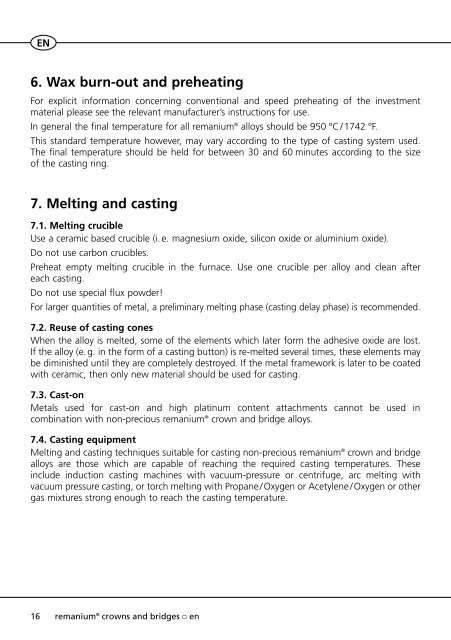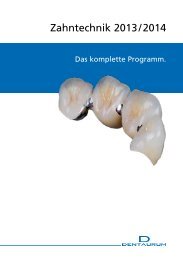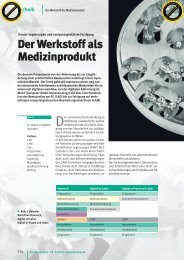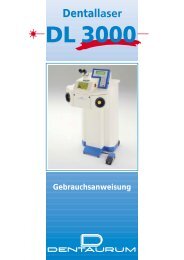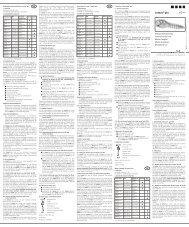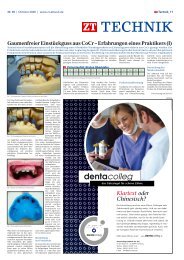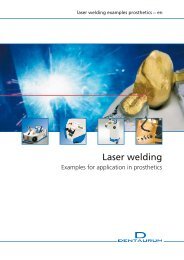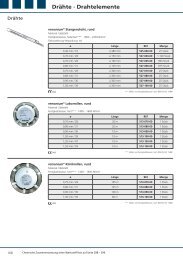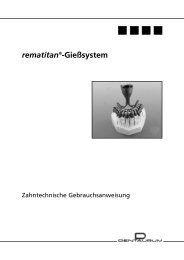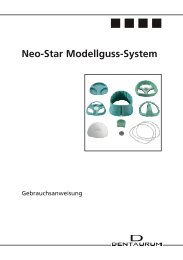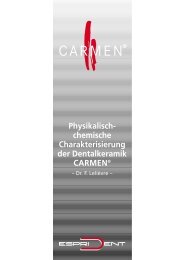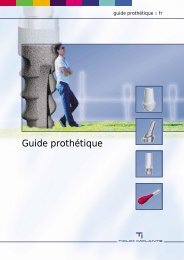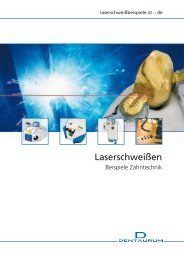remanium® K+B Gebrauchsanweisung - DENTAURUM
remanium® K+B Gebrauchsanweisung - DENTAURUM
remanium® K+B Gebrauchsanweisung - DENTAURUM
You also want an ePaper? Increase the reach of your titles
YUMPU automatically turns print PDFs into web optimized ePapers that Google loves.
EN<br />
EN<br />
6. Wax burn-out and preheating<br />
For explicit information concerning conventional and speed preheating of the investment<br />
material please see the relevant manufacturer’s instructions for use.<br />
In general the final temperature for all remanium ® alloys should be 950 °C / 1742 °F.<br />
This standard temperature however, may vary according to the type of casting system used.<br />
The final temperature should be held for between 30 and 60 minutes according to the size<br />
of the casting ring.<br />
7. Melting and casting<br />
7.1. Melting crucible<br />
Use a ceramic based crucible (i. e. magnesium oxide, silicon oxide or aluminium oxide).<br />
Do not use carbon crucibles.<br />
Preheat empty melting crucible in the furnace. Use one crucible per alloy and clean after<br />
each casting.<br />
Do not use special flux powder!<br />
For larger quantities of metal, a preliminary melting phase (casting delay phase) is recommended.<br />
7.2. Reuse of casting cones<br />
When the alloy is melted, some of the elements which later form the adhesive oxide are lost.<br />
If the alloy (e. g. in the form of a casting button) is re-melted several times, these elements may<br />
be diminished until they are completely destroyed. If the metal framework is later to be coated<br />
with ceramic, then only new material should be used for casting.<br />
7.3. Cast-on<br />
Metals used for cast-on and high platinum content attachments cannot be used in<br />
combination with non-precious remanium ® crown and bridge alloys.<br />
7.4. Casting equipment<br />
Melting and casting techniques suitable for casting non-precious remanium ® crown and bridge<br />
alloys are those which are capable of reaching the required casting temperatures. These<br />
include induction casting machines with vacuum-pressure or centrifuge, arc melting with<br />
vacuum pressure casting, or torch melting with Propane / Oxygen or Acetylene / Oxygen or other<br />
gas mixtures strong enough to reach the casting temperature.<br />
8. Induction melting with vacuum pressure casting machines<br />
Set vacuum to 250 – 450 mbar (recommended pressure: 450 mbar).<br />
8.1. Premelting<br />
Premelt the ingots until they are red hot (no visible rounding at the corners of the ingots).<br />
8.2. Melting<br />
Melt until the oxide layer of the molten metal breaks open, then cast immediately.<br />
With exception of remanium ® LFC: after the molten shadow disappears, continue heating for<br />
2 – 4 seconds before the oxide layer cracks up, and then cast (see alloy info supplement).<br />
Observe the melting procedure and initiate the casting procedure manually. Oxides formed<br />
during melting (cf. melting illustrations in the operating instructions for the pressure casting<br />
machine) remain as slag in the crucible after casting and can be easily removed. If the correct<br />
melting and casting technique is used, there is only a minimum residue in the crucible and the<br />
molten metal is not overheated.<br />
Automatic casting with a pyrometer control is unsuitable, as the pyrometer cannot always<br />
accurately determine the right time for casting.<br />
9. Induction melting with centrifugal casting machines<br />
Wait until the last casting cylinder has collapsed, the oxide layer of the molten metal has broken<br />
and then cast immediately.<br />
With exception of remanium ® LFC: after the melt shadow disappears, cast immediately<br />
(see alloy info supplement).<br />
We recommend premelting the metal if a large amount is to be cast.<br />
10. Melting with torch<br />
When melting, the remanium ® crown and bridge alloys show a clean melt without sparks.<br />
Caution! Use torch with shower head nozzle!<br />
4 – 5 mm<br />
a) Propane / Oxygen Melting<br />
Select maximum burner setting as stated by manufacturer.<br />
Oxygen 2 – 3 bar.<br />
b) Acetylene / Oxygen Melting<br />
Follow instructions of burner manufacturer.<br />
Acetylene: 0.7 bar, oxygen 3 bar.<br />
16 remanium ® crowns and bridges en<br />
remanium ® crowns and bridges en 17


